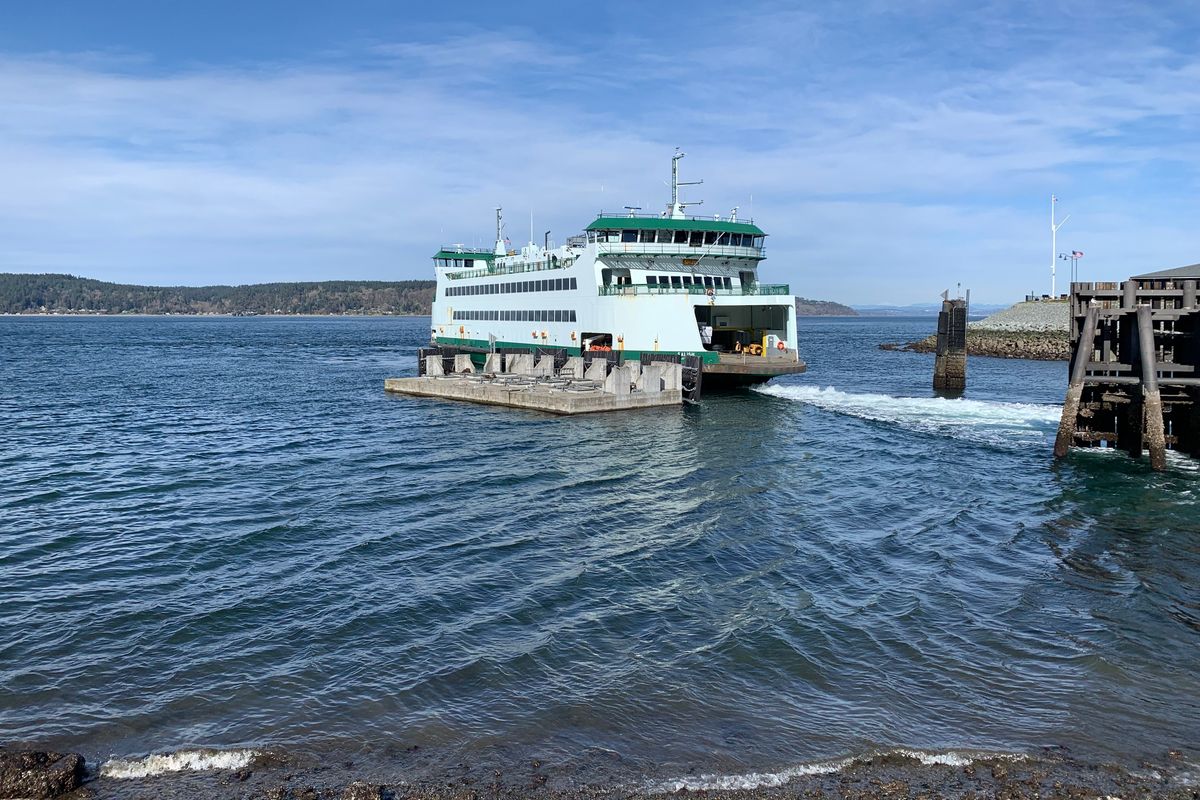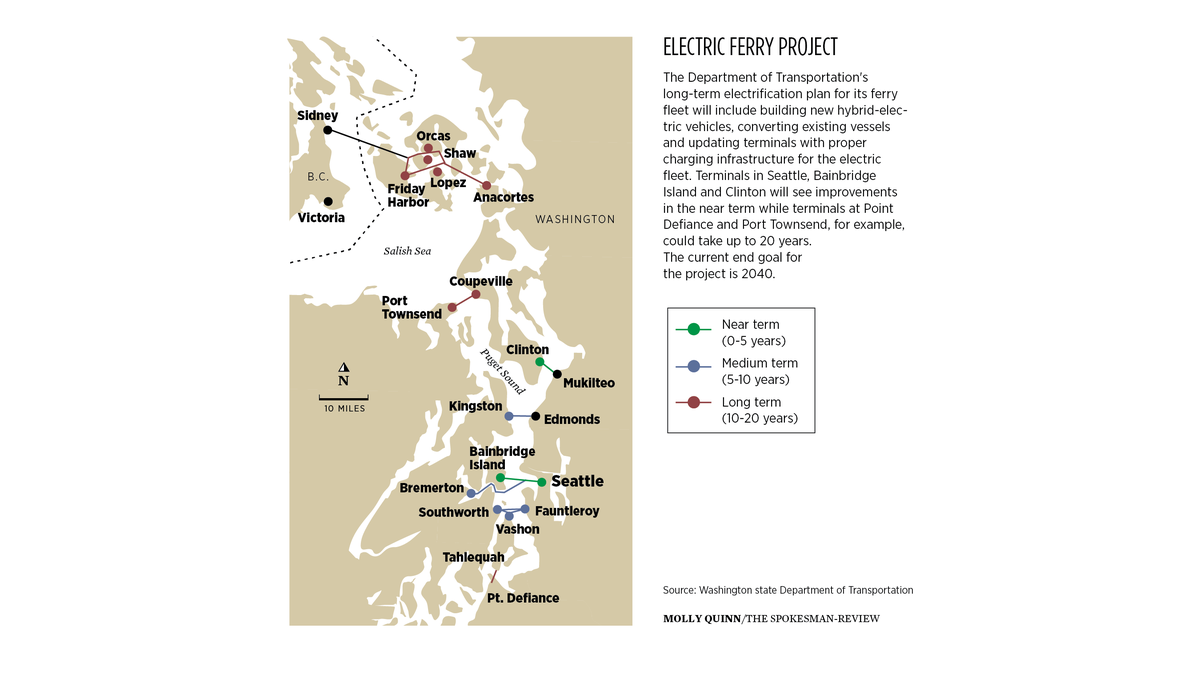Getting There: Inslee signs transportation package into law with funding for new electric ferries
The M/V Salish ferry departs Point Defiance in Tacoma for Tahlequah on Vashon Island on Thursday. The state Department of Transportation is working to electrify its ferry fleet and stations. The Point Defiance-Tahlequah route is part of the long-term planning, meaning the terminal will not be hybrid-electric enabled for at least 10 years. (Laurel Demkovich / The Spokesman-Review)Buy a print of this photo
OLYMPIA – New funding for transportation over the next 16 years means new transit, bicycle and pedestrian projects, maintenance of roads and electrifying the ferry fleet in Washington.
At a visit to the Mukilteo Ferry Terminal, Gov. Jay Inslee on Friday signed a number of transportation and climate bills, including the revenue portion of the $17 billion transportation package.
“This is another step forward in revolutionizing our transportation system and revolutionizing our energy system in the state of Washington,” Inslee said.
Department of Transportation Secretary Roger Millar said at the signing Friday the package will allow the state to transition its ferry fleet to cleaner electric and hybrid vessels.
The package is “significant for transportation in our state,” Millar said.
Along with a number of local and statewide road and transit projects, the 16-year package provides $193 million for terminal electrification and vessel electrification. It also provides more than more than $836 million for construction of four new hybrid-electric vessels.
In January 2020, Inslee signed an executive order ordering the ferry system to move toward a zero emissions fleet. With the new funding signed Friday, Inslee said electric hybrid ferries soon will “cleanly and quietly sail on marine highways.”
The funding is part of a larger electrification plan that the Department of Transportation is starting this year. The plan calls for building 16 new hybrid-electric vessels, converting six existing vessels and electrifying 16 terminals by 2040.
According to the department, the state’s ferries burn more than 18 million gallons of diesel fuel each year. When an electrification plan is in place, the department estimates it will reduce emissions by up to 53% by 2030 and 76% by 2040.
To achieve the goal of a zero emissions fleet, DOT is focusing on three components: building new hybrid-electric vessels, converting six vessels to hybrid-electric and developing terminal charging infrastructure.
The funding in the transportation package will be enough to begin work on four new hybrid vessels, to convert three jumbo vessels and to bring power to five terminals, said DOT spokesperson Suanne Pelley.
That is in addition to one new hybrid vessel, recently named “Wishkah,” that had already been funded. Construction on it will begin this year, with an end goal of 2025.
Conversion of the first existing ferry will begin in late 2022.
Terminal charging must also be in place to operate an electric fleet. That means the department will need to build charging infrastructure, which is currently planned at 16 of their terminals.
Charging a ferry starts with establishing connections to an existing power grid from a local utility or distribution lines. Once that is set up, power can be sent to a converter at the terminal. It must then be transmitted to the charging system on the wingwall, or the area where vessels are secured at a terminal. From there, a vessel can hook up to the charging arm that will have a large square that boats can pull up to.
All of the infrastructure needed to do that, however, must still be built.
Preliminary engineering work has already started at some terminals to determine how to get power from main sources to the charging arm that boats will use, Pelley said. The five that received funding in the transportation package are at Seattle, Bainbridge Island, Clinton, Kingston and Bremerton.
With the state funding passed this year along with previous federal and state funds, the project now has $1.3 billion to work with, Pelley said. But there is still much more work to be done.
She said the department will continue to look at federal and state grant funds to secure money for future work. She said there has been “incredible support” from the Legislature and Inslee for this plan. Funding from the Legislature this year will allow a lot of the work to start.
“As with all mega projects, you bite off pieces at a time,” she said.
Along with the revenue bill for the transportation package, Inslee on Friday signed a number of bills that aim to reduce methane emissions and create cleaner buildings. The new laws would reduce methane emissions from landfills, divert organic material and food waste from landfills and expand the state’s clean building policy to buildings over 20,000 square feet, such as multifamily buildings.
“We’re going to beat climate change not by one silver bullet,” Inslee said. “We’re going to have to do a thousand things.”
At a later event at Pierce Transit’s Tacoma Dome Station, Inslee signed the supplemental transportation budget, the spending bill for the transportation package and a number of bills to invest in projects for clean technology manufacturing.
Work to watch for
Two major road projects begin this week within Spokane city limits.
The $8.9 million reconstruction of the Thor/Freya couplet begins Monday. The eastbound I-90 ramp at the intersection will be closed. Motorists are encouraged to exit at Altamont.
Thor Street will be closed from Sprague to Fifth Avenue. Traffic will be diverted to Freya, which will become a two-lane road.
The work will be done in seven phases, and is scheduled for completion in late September.
Crews will begin work replacing the Hatch Road bridge deck on Tuesday. The bridge will be closed for approximately four months, as will the northbound right lane of Highway 195.
To access Hatch Road from the north, use High Drive or 57th Avenue. To access from the south, continue north on U.S. 195 to I-90 East, then use the Maple Street exit to travel south on Cedar Street to High Drive.
The $1.9 million project is expected to be complete at the end of July.
Editor’s note: This story has been update to correct the funding numbers provided for ferry electrification in the 16-year transportation package.

